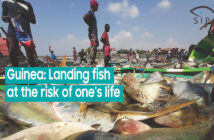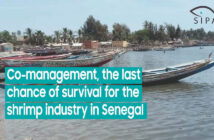Faced with the increasing scarcity of fish and to meet their needs of animal proteins and enhance the flavour of their cuisine, the populations of southern Benin are heavily engaged in harvesting shellfish. Along the shores of Lake Nokoué in Cotonou, along the coastal lagoon of Djebadji and in the lakeside villages of Gogotinkpon and Sô-Ava, children, women and men all go in search of these edible shellfish, which are a source of income helping them to get by with their precarious situation. But this activity involves challenges and risks.
By Marie-Louise Félicité BIDIAS
The famous Lake Ahémé is a huge water body at the edge of which are located several communes in southern Benin including the districts of Angbanto and Gogotinkpon in the Kpomassè commune. A land, along the stream line, appears away against the backdrop of the waterbody through a mangrove forest.
The village seasonal fishing activities is ongoing with the women harvesting shellfish and the men busy getting fish. From one clump of mangroves to another, plunging down to the roots of the mangroves, they come out with closed hands and open them into a nearby canoes meant for the purpose.
Starting in May and lasting three to four months, these shellfish are generally sought after by women. There are hidden treasures in the mangroves bordering the lake, in the coastal lagoons (Djègbadji, Togbin and Djondji), along the rivers of the West (Mono and Sazué) and in Cotonou on the bank of Lake Nokoué on the way to Sô-Ava.
The Shellfish in all its forms
Commonly called “adakpin” in the (Fon) location language, among other uses of shellfish in Benin, this is their contribution to the diet. They are indeed used to prepare a local sauce commonly called «Dja» (made with tomatoes, shellfish and crushed shrimps), which is served with other dishes such as rice, « ablo » (local fermented corn cake).
In Gogotinkpon, Odile Tossavi, 47 years old, mother of 5 children, has been harvesting shellfish for a long time. Sitting in front of a full bowl, she is busy getting them out of their shells, her left hand wrapped in a cloth to protect herself from possible cuts from her knife. « Yes, I manage to make a profit and take care of my little family. Except that the activity is seasonal», she whispers. « Sometimes I can sell up to 3,000 to 5,000 CFA francs a day or even more, » she says.
Speaking in Pedah, the local language, she went on saying that the equipment used to perform this activity is very basic. Ferries and dugout canoes are generally community-based. « We rent them at a fixed price of 500 or 1,000 CFA francs per day, depending on their size ». Ahondé, another elderly woman says: « Apart from this heavy equipment, we also use large basins, knives and sturdy gloves. The basic purchase cost of all this is about 6,200 CFA francs».
She as well advises that the harvested shellfish must be kept into a salted water to prevent them from dying. In the village, it is mainly women who harvest these shellfish. «There is no law preventing men from harversting shellfish. Only thath, the men are more interested in catching fish. But with the growing unemployment in the villages and given the scarcity of fish, some men started getting into shellfish harvesting business», says Olivier Avlessi Zounon born and bred In Cotonou.
Augustine Dansou, a mother of four, has been a shellfish street retailor for five years now. She is originally from Sô-Ava, another lakeside settlement where shellfish product is equally abundant. From dawn to dusk, she travels around the city of Cotonou. On her head is a huge tray on which are piled small basins filled with salted water. She is carrying about 18 of them. « The shellfish contained in each small basin cost 800 Fcfa, » she explains in Fon.
On Lake Nokoué, it is the men that harvest them. « We buy the product from the men and retail it to. The men are the ones who set the selling price ». As she is in a hurry, she asks a passer-by to help her put her heavy tray back onto her head. « I have to deliver to a client who’s already waiting for me. Yes, I earn a good living and I even manage to save some money every week in a tontine [a regular savings system used by many traders, N.D.A.]», she says, before walking away with her product worth 14,400 CFA francs.
 On the shores of Cotonou’s Lake Nokou, in the Ahouansori district, Akpovi, a shellfish harvester in his fifties testifies: «When the time to harvest the shellfish approaches, like now, we go out very early in the morning and at a certain point, we throw the bait into the lake to attract the shellfish. Very easily, they come to clump together and then we pick them up». This former fisherman, who is now shellfish harvester, says in a sad tone that it is due to fish scarcity that he undertook harvesting shellfish. «We don’t sell anything, the women do that, » he nods as he speaks, the weight of age and the difficult working conditions have not spared him.
On the shores of Cotonou’s Lake Nokou, in the Ahouansori district, Akpovi, a shellfish harvester in his fifties testifies: «When the time to harvest the shellfish approaches, like now, we go out very early in the morning and at a certain point, we throw the bait into the lake to attract the shellfish. Very easily, they come to clump together and then we pick them up». This former fisherman, who is now shellfish harvester, says in a sad tone that it is due to fish scarcity that he undertook harvesting shellfish. «We don’t sell anything, the women do that, » he nods as he speaks, the weight of age and the difficult working conditions have not spared him.
Fabrice Ahomlanto, Food Technology Engineer, Head of the post-harvest division at the Fisheries Directorate within the Ministry of Agriculture, Animal Husbandry and Fisheries, points out that the Ministry pays very little attention to the issue of shellfish harvesting, leaving the women to fend for themselves, without any relevant medical check-ups.
From his view point, this is because shellfish harvesting is a seasonal activity and doesn’t involve a lot of people. « We can’t do it the way we do it with the women smoking and drying fish, » he says. For the fish processing (smoking and drying) women, health check-up is carried out prior to and after the drying and smoking activities. Likewise, the working facility is to be checked for cleanliness, non-contamination, packaging and the quality of the fish smoking firewood.
Alongside the road leading to the fishing area, on the way to Ouidah (historic town, former slave port), Jebadji is also known for its fishing activities. The sight of empty shells from shellfish piled up and on sale is an indication of how close they are to the area. These shells are generally used to build houses’ foundation and for animal food.
The sale price depends on the requested shells ‘quantity. Houlahoué Accrombessi, the product’s saleswoman, specifies that it is the young girls and boys who collect shells. It is done either on foot or with the help of a rowing boat. In the morning, at sunrise, the collectors leave their homes and move in all directions in search of these aquatic shellfish.
« I sell my bowl for 1,000 Fcfa and make a good living out of it. We’re in the right season. Sometimes, the canoes come back full of shellfish». Here too, she has the same complaint, as seasonal activity leaves her hungry for the rest of the year. « If it were possible to grow them all throughout the year, I would be ready, » she says, as demand is always very high, even during off-season.
Marcel Goudohessi, in charge of fisheries and aquaculture products control, at the Directorate of Agriculture, Livestock and Fisheries, Ouidah zone 3, informs that « the fisheries products control, is carried out in relation to hygiene, cold chain and equipment compliance, the product conservation and handling. While that of aquaculture products is more in fish farming». Here again very little attention is paid to comestible shellfish. The challenge in getting shellfish statistics available in the field was also felt throughout the survey. It is also well known that the mangroves are seriously threatened. These include: lack of visibility in the policy and non-compliance with regulations on the rational management of wetlands as the ecosystems are very fragile.
The framework law of 7 August 2014, relating to Fisheries and Aquaculture in Benin, would still benefit from being further reviewed in order to grant more consideration to these comestible shellfish as well.
Hand cuts and feet injuries, standing into water for long hours, being exposed to all kinds of hazards as a result of cool water during the months of June, July and August. The rising waters during flood times, leading to the loss of shellfish species, the lack of means of transport and the use of outdated equipment, are among others challenges faced by the majority of women and men. However, when the season sets in, they do not hesitate to jump on it as it is a source of livelihood.
To be continued…
There is no longer any discussion about the fact that fishing activity by itself alone can no longer meet the ever-increasing demand. For many, aquaculture appears to be the strategic economic sector for ensuring food sovereignty, and trade balances. The exploitation of comestible shellfish is also a good way out, to address poverty in general, and for women in particular, and ensure their financial reliability.
Cosme Koudenoukpo, from the Hydrobiology and Aquaculture Laboratory at the University of Abomey-Calavi points out that: « Like fish farming, which is strongly encouraged, the development of the farming of two species of comestible shellfish, the Laniste varicus snail and the Etheria elliptica oyster, which have been identified, will reduce the fishing pressure on the water resources and generate more jobs».
According to Mr.Casme, it is essential to alleviate poverty, ensure higher incomes and improve economies. « to ensure food security and availability to great number of people and making sure that the people involved in aquaculture enjoy better life », he indicates.
There is a lack of relevant processing and storage facilities for shellfish products, which are harvested in unfavorable and still archaic conditions, not to lose sight of the risks incurred by women and children. According to Pascale Legué and Jean Prou, another solution to make the shellfish business more sustainable can be oyster farming, i.e. its rearing. However, resources are still to be put in place and subsequent measures taken for that purpose.
What is needed is to get these men and women shellfish harvester organized into associations, modernize their fishing techniques and encourage their consumption on a large scale. The State would really benefit from becoming more involved and injecting substantial resources to help this category of population!




